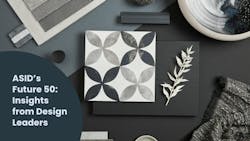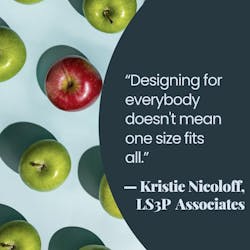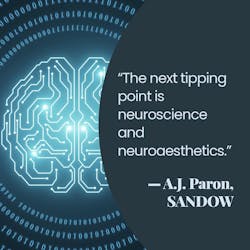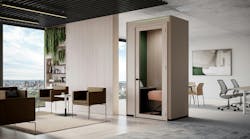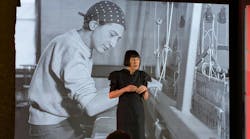7 Ideas Shaping the Future of Interior Design from ASID’s Future 50
The future of commercial interiors is being reimagined at the intersection of sustainability, inclusivity, and health. As part of the NeoCon 2025 virtual CEUs, ASID’s panel “The Future 50: Trends Imagined for Tomorrow” brought together leaders from practice, product manufacturing, and design strategy to explore what’s next. Their insights highlight urgent challenges—from circular design and net-zero goals to neurodiversity and data-driven innovation—and the opportunities designers have to mold a better future. Here are seven snack-sized takeaways from our “editor’s notebook” that are worth packing for your next project.
1. Circularity Is Non-Negotiable
LS3P Associates′ Kristie Nicoloff was unequivocal: “We have to really start to understand that circular economy model” by continuing to explore and implement upcycling, regenerative design, and resilient design to adapt to climate events.
Andreu World regional manager Michael Cook added urgency from the manufacturing side: “The manufacturer should consider end-of-life” before a product ever launches, he advised.
2. Design for Disassembly and Takeback
Jasani Studio founder Ruju Jasani noted, “Interior projects generate waste at a greater pace than architecture.” She stated that durability and return programs are critical to offsetting such waste.
Cook concurred, saying, “A nationwide takeback program is absolutely essential.”
3. Inclusivity Starts in Predesign
Jasani said, “The predesign phase is crucial for inclusivity.” Bringing in diverse stakeholders ensures a holistic approach to defining the program.
SANDOW design futurist A.J. Paron cautioned: “Many times [inclusivity] gets value-engineered out in programming.” Therefore, designers need to lead with urgency.
4. Designing for Neurodiverse Needs
According to Paron, “gentle” is the key design aesthetic for the neurodiverse.
Nicoloff countered: “There are choices—designing for everybody doesn’t mean one size fits all” but rather that a range of options is available to project stakeholders.
5. Data-Driven Design as Standard Practice
Cook emphasized that “data-driven design is critical to launching products that meet client needs,” and should consider factors such as body type, shape, neurodiversity, material safety, and chemistry, among others.
Paron advised that where stakeholders surveys fail to capture diverse needs, designers must “watch behaviors” […] and “find the middle ground solution.”
6. Resilience and Health Are Linked
Nicoloff revealed that during future trends committee discussions, resiliency and AI emerged as top priorities. Future tools such as more accurate carbon-footprint models could go a long way toward improving assessments that inform projects with different resilient design scenarios. Applying data and analysis from past climate events, such as severe hurricanes and wildfires, can aid architects and designers to build healthier, more secure environments.
7. Collaboration Will Drive the Next Breakthroughs
Paron’s prediction? “The next tipping point is neuroscience and neuroaesthetics.” Continued research into how design influences the brain will bring new opportunities for evidence-backed design, she elaborated.
Cook forecasted that partnership across disciplines would be the key to moving design practice and product development forward on the same track. “Collaboration across design and manufacturing will level everyone up.”
From takeback programs to neuroaesthetic design, ASID Future 50 panelists agreed: The next 50 years of interiors demand both bold innovation and grounded responsibility. For commercial designers, that means intentionally weaving sustainability, inclusivity, and health—for people and the planet—into every project.
More from NeoCon 2025
NeoCon virtual CEUs are available for a limited time after the in-person event. Keep apprised of next year’s programming by bookmarking the NeoCon website, and subscribe to our i+s Insider newsletter for industry updates including speakers, activations, themes, and more.
About the Author
Carrie Meadows
Editor-in-Chief
Carrie Meadows is Editor-in-Chief of interiors+sources (i+s), where she leads editorial strategy, content development, and brand storytelling focused on the people, projects, and innovations shaping the design industry. With more than two decades of experience in B2B media, she has built a career connecting technical expertise with creative insight—translating complex topics into meaningful stories for professional audiences. Before joining i+s in 2024, Carrie served as Editor-in-Chief of LEDs Magazine within Endeavor Business Media’s Digital Infrastructure & Lighting Group, guiding coverage of emerging lighting technologies, sustainability, and human-centric design. Her earlier editorial experience spans across Laser Focus World, Vision Systems Design, Lightwave, and CleanRooms, where she managed print and digital publications serving the optics, photonics, and semiconductor sectors.
An advocate for clear communication and thoughtful storytelling, Carrie combines her editorial management, SEO, and content strategy expertise to help brands and readers stay informed in a rapidly evolving media landscape. When she’s not crafting content, Carrie can be found volunteering at a local animal shelter, diving into a good crime novel, or spending time outdoors with family, friends, and her favorite four-legged friends.
